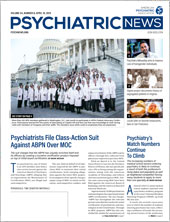New best practices aimed at evaluating and treating youth with agitation in the emergency department (ED) have been issued by the American Association for Emergency Psychiatry.
An increasing number of children and adolescents are presenting in the emergency room for psychiatric concerns, but most EDs don’t have a psychiatrist—child or generalist—or even a mental health specialist on staff.
“Emergency rooms can be really stressful places for adults, let alone children with a history of anxiety or aggressive behavior,” said guideline co-author Ruth S. Gerson, M.D., director of Bellevue Hospital Children’s Comprehensive Psychiatric Emergency Program and an assistant professor in the Department of Child and Adolescent Psychiatry at New York University School of Medicine.
The guidelines were created by consensus of a work group of 17 experts in emergency child and adolescent psychiatry and psychopharmacology. The basic thrust of the guidelines is that nonpharmacological approaches should be implemented first to prevent and de-escalate agitation—before medications are considered—in part because calming measures can work just as well as medications. For example, the guidelines state that communicating in a neutral yet empathic tone, as well as “reunification with (or separation from) family members, food, drink, distraction, preferred comfort items from home, or sensory coping kits can ease tension.”
When medications are needed, the etiology of the agitation should guide their use, as well as the patient’s individual needs and the treatment setting itself, according to the guidelines. Children with agitation in the ED are too often put in physical restraints—as many as 1 in 10—and dozens of children have died in restraint-related incidents in various settings throughout the United States.
“Restraints should be reserved as an absolute last resort because they can be really dangerous for the child, as well as traumatizing for the child and the family,” Gerson said. “That’s not the experience of mental health treatment that we want a child to have.”
To date, there have been no randomized clinical trials (RCTs) or comparative studies of what medications are effective to treat youth for agitation in the ED setting. The sole RCT of medications for acute agitation in psychiatrically hospitalized youth found no difference between one commonly used medication, diphenhydramine, versus placebo.
Because of the lack of consensus about which medications are most helpful, ED physicians often resort to using the same medications that have been shown to be helpful in adults, although this is not the best strategy, Gerson said. “Children’s bodies are different, their psychopathology is different, and their reasons for being in the emergency room are often different from those of adults. There is no evidence that the same medications that are effective for adults are effective for children.”
Furthermore, not all agitation is the same, and treatment should be rooted in an attempt to address the suspected etiology of the patient’s agitation, Gerson said.
“Agitation is a symptom, like pain, not a pathology in and of itself. It’s a failure of our training programs that we have gotten very good at assessing people in pain, but we have not gotten good at assessing people experiencing agitation.”
The consensus guidelines were written to give ED physicians as well as pediatricians a framework with which to think about managing youth agitation. The guidelines call for more training of ED physicians and staff in rapid diagnosis and stabilization of agitated youth; support for nonpharmacologic de-escalation and crisis management; and further research into understanding, preventing, assessing, and treating agitation in youth in the ED.
Agitation in Children Demystified
According to the guidelines, the five most common etiologies of agitation among children—along with a summary of some the corresponding consensus medication regimens—are as follows:
•
Delirium: Identify and treat underlying etiologies. Reduce or discontinue medication that may be causing delirium, limit exposure to opioids for pain that can worsen delirium, support sleep, and address pain or nausea. Finally, address specific symptoms of agitation as needed for safety with second-generation neuroleptics such as risperidone, olanzapine, or quetiapine. Avoid diphenhydramine, benzodiazepines, and anticholinergics.
•
Substance intoxication/withdrawal: The guidelines suggest specific drug regimens based on the substance ingested. If urine toxicology is negative, physicians should suspect newer synthetic drugs, such as synthetic cannabinoids and cathinones. If the substance ingested remains unknown, lorazepam can be used, and potentially combined with haloperidol if the patient is severely agitated and hallucinating.
•
Developmental disability/autism spectrum disorder: Physicians should attempt behavioral interventions, including asking caregivers what usually soothes the child and how the child has responded to medications in the past. Youth with autism or developmental disabilities are at higher risk for delirium and psychiatric symptoms. They also can be particularly vulnerable to adverse drug events from many of the medications used to treat agitation, particularly benzodiazepines.
•
Psychiatric diagnosis: Physicians should utilize de-escalation strategies. Patients with a psychiatric illness who have missed their medication they take at home and are becoming agitated as a result should be administered a dose of their regular medicine. In other cases, an extra half dose or full dose of their regular medicine can help alleviate agitation. The guidelines include specific medication regimens based upon the youth’s diagnosis and reasons for agitation.
•
Unknown etiology: For youth with agitation for whom it is not possible to identify the etiology, de-escalation strategies should be used while assessing possible triggers for the agitation. For moderate agitation, lorazepam, diphenhydramine, or olanzapine can be used. ■
“Best Practices for Evaluation and Treatment of Agitated Children and Adolescents (BETA) in the Emergency Department: Consensus Statement of the American Association for Emergency Psychiatry” can be accessed
here.

